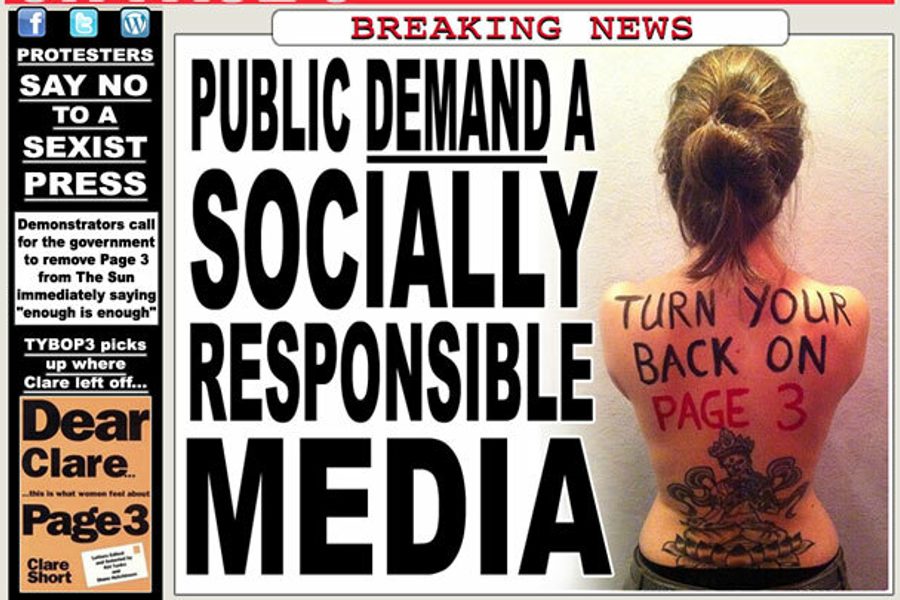Turning the Page on Page 3 Girls
Feminist groups want to rid U.K. media of sexism. Easier said than done.
Jude Ellison Sady Doyle

When the Leveson Inquiry was called for last July after the phone-hacking scandals surrounding Rupert Murdoch’s media empire, it had very specific goals. It was called to investigate the precise involvement of the media and the police in the hacking, advertising itself as an inquiry into “the culture, practices and ethics of the press.” The inquiry’s website declares that “In particular, Lord Justice Leveson will examine the relationship of the press with the public, police and politicians.
Which makes this, among other things, a story about choosing your words carefully. As it turns out, U.K. feminist groups have several ideas about what’s wrong with the media’s “culture, practices and ethics.” Five different groups – ranging from the august and global Equality Now to Turn Your Back on Page 3, the web presence of which is comprised of a Wordpress blog – are now pushing for the inquiry to investigate the culture of sexism in British media.
And so we face some very tricky questions: Can we regulate something as multidimensional as “sexism in media?” How would we do so? And: Does anyone know, for certain, all of the “sexism in media” that has to be dealt with?
Broad, noble goals
Along with Turn Your Back on Page 3 and Equality Now, there are several very different groups now pressuring the Leveson Inquiry. There is OBJECT, a group which protests “the sexual objectification of women and girls, and the mainstreaming of the sex and porn industries in the media and popular culture,” with the aim of ending “sex object culture,” and which is working with Take Back Page 3. There is Eaves, which provides peer support groups for sexual assault survivors and housing for survivors of domestic violence. And there is the End Violence Against Women Coalition (EVAW), the goals of which are “to end all forms of violence against women and girls.”
It’s no surprise, then, that the problems and demands presented to Leveson (and his “panel of six independent assessors with expertise in key issues” – it’s unclear if sexism is one of those issues) are broad-ranging. The OBJECT/Turn Your Back On Page 3 report cites topless photos newspapers (for example, the topless-photo feature on Page 3 of The Sun). Equality Now, in a statement e-mailed to me, recommended “awareness-raising and educational campaigns directed at women and men, and specifically at media and advertising agencies, to help ensure the elimination of stereotypes regarding the roles of women and men in society and in the family.”
The EVAW report focuses largely on the ethics of reporting: It cites harassment of female celebrities, reporters who are not trained on protocol around reporting rape cases or maintaining victims’ anonymity. (OBJECT also notes the reporting of domestic violence cases as “odd news:” “A man’s planned threesome with his wife and another woman ended with him behind bars – when he threw a TELLY at his missus!‟) And, finally, there is the presence of material, written or at least dictated by women, which – in the words of the OBJECT report – “is clearly intended to titillate the reader (presumed male).”
Which is the trouble. Despite the noble goals of the groups pressing for this inquiry, and despite the clear and toxic sexism of the material they cite, some of their suggestions are not something that any American feminist can reasonably support.
Titillation and regulation
“Now that the Leveson inquiry has opened the floodgates of public scrutiny of the British press, orthodoxies that were previously held to be unassailable are now being challenged,” says Laurie Penny, a British journalist with extensive experience in both the U.K. and the United States, who has written favorably about this matter for The Guardian.
Penny says that in the U.K., standards of journalistic training are far more lax than they are in the United States. So are the standards for what is printable: “[The] question of ethics in journalism is more fungible and down to the conscience of the individual reporter or editor. The key issue in deciding whether or not to include a given story or piece of information is, ‘Is this likely to infringe UK libel law?’ [Which] is definitely not the same thing as, ‘Is this true?’”
The result is a culture of reporting that is often sloppy, frequently sensational, and not above a cheap shot. And misogyny is a cheap shot that reliably sells papers. Such a culture is not unfamiliar to American readers, though we typically don’t have topless photos in papers.
But the question of regulating that culture is tricky. Consider this passage from the OBJECT/Take Back Page 3 report:
“The sexual objectification of women is found implicitly” – how implicitly? – “to encourage, normalise and legitimise attitudes associated with discrimination and violence against women and girls.” Which attitudes? And how? “This is of grave concern” – is it? If we don’t know what evidence it’s founded on, why? – “when we live in a society in which one in three women will experience male violence in her lifetime.”
That last clause is true. It just happens to rest on the hypothesis of a causal link between sexualized images and violence against women – an assertion OBJECT does not conclusively prove, or cite research to support, in its report. EVAW makes similar claims, with a similar lack of outside research to back them up; one study (PDF link) cited by British psychologist Linda Pappadopolous, who was in turn cited by EVAW and OBJECT, did apparently prove that “high pornography use is not in itself an indicator of high risk for sexual aggression. However, adults who are already predisposed to violent activity and who also score high for pornography use are much more likely to engage in sexual aggression.”
How much more likely? It doesn’t say. What proof is there that the pornography use preceded or incited the sexual aggression, rather than being a result of it? We don’t know.
This may seem unsisterly. But, in fact, this hypothetical causal link would be the basis for not allowing certain material to be published. And it’s deeply unwise to base such a policy on a phenomenon that may not exist. Similarly, banning “titillating” material, even material created by women, is frightening. The stories in question are cheap “real college girls talk about sex” stories, of the kind you can find anywhere. But where does one draw the line, on “titillation?” Where do Terry Richardson photos go? What about photos by Annie Liebowitz? In one of her books, the feminist poet Eileen Myles includes a long passage describing and praising her lovers’ vulvas, also known as “pussies.” Things are done for the pussies; functions of the pussies are celebrated; varying shapes and sizes of pussies are discussed.
I, for one, was titillated. And this section was published by VICE magazine in 2009. Would this be unwelcome, in the media as defined by OBJECT? Would this be unallowable sexism?
The obvious omission
Many of the recommendations made by the U.K. feminist groups are good ones. Better training for reporters, and better ethics when reporting on rape and domestic violence, are urgently needed. The connection between sloppy and unethical rape reporting and the endangerment of rape accusers, or the perpetuation of misunderstandings about rape, certainly does exist.
As Penny notes, “[some] of the suggestions put forward by feminist groups in the U.K. – such as greater training for journalists in the law on violence against women – might, in fact, be of more use in countries like the USA where more journalists are actually trained.” True enough.
But it’s strange to review all these reports and documents on sexism in media, and how to combat it, and to not see the most obvious solution recommended first. In all these pages and pages of writing, by women, about women, for women, we seem to miss it. That is: Perhaps the problem could be resolved if there were more newspapers staffed and run by feminist women.
Jude Ellison Sady Doyle is an In These Times contributing writer. They are the author of Trainwreck: The Women We Love to Hate, Mock, and Fear… and Why (Melville House, 2016) and was the founder of the blog Tiger Beatdown. You can follow them on Twitter at @sadydoyle.








